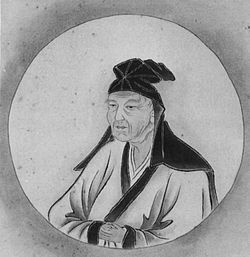Confucian Shinto
Confucian Shinto is a Japanese religious tradition. It started in Japan during a time called the Edo period. This was from 1603 to 1868.[1] It mixes parts of Confucianism and Shinto. Confucianism is a Chinese way of thinking and acting. Shinto is the original religion of Japan.[2][3] Some people also call Confucian Shinto "Neo-Confucian Shinto". This is because it uses parts of Confucian teachings in Shinto beliefs and ways.[1] There are groups today linked with Confucian Shinto. These groups are Shinto Taiseikyo,[4][5] Shinto Shusei,[4][5] and Tsuchimikado Shinto.[6] Suika Shinto was a known school of Confucian Shinto but no longer exists, it was founded by Yamazaki Ansai.[7]
History
Confucian Shinto started in the 17th century. This is when Japanese people started to read Chinese Confucian books. They put Confucian ideas into their understanding of Shinto. A big name in this was Yamazaki Ansai. He lived from 1618 to 1682. He made a mix of Confucianism and Shinto. This mix focused on good behavior and respect for parents.[2]
A student of Ansai, Kaibara Ekken, further developed these ideas. Ekken lived from 1630 to 1714.[8] He wrote many important books on Confucian Shinto. One of these books is called the "Greater Learning for Women." Ekken's books stressed the need for education and becoming good. He said Confucian ethics should be part of daily life.[9]
In the 18th and 19th centuries, Confucian Shinto became more liked by the samurai class. They thought it helped them balance their duty to the emperor with their Confucian ideas. These ideas were about loyalty, honor, and being right.[2] Regular people also liked Confucian Shinto. They were drawn to its focus on family values and everyday ethics.[3] A thought by Wang Yangming was very important to Confucian Shinto. This thought was about the unity of knowledge and action.[2]
Influence and Legacy
Confucian Shinto had a significant impact on Japanese society during the Edo period and beyond. It helped to shape the moral values and social norms of the samurai class,[2] and played a role in the development of modern Japanese nationalism.[7]
Confucian Shinto also had an influence on the Meiji Restoration of 1868, which marked the end of the Edo period and the beginning of modern Japan. The leaders of the restoration sought to revive traditional Japanese values and culture, and saw Confucian Shinto as a way to do so. They promoted the idea of kokutai, or the "national essence", which was based on the Confucian notion of the ruler-subject relationship and the Shinto idea of the emperor as a divine being.[7] Fukko Shinto which was also quite significant developed in reaction to Confucian Shinto,[10] and it was the predecessor to State Shinto.[11]
Modern groups
In Sect Shinto, Shinto Taiseikyo and Shinto Shusei are groups with Confucian influence.[12] Tsuchimikado Shinto also carries on this legacy.[6] But it is not a member of the Sect Shinto association.
References
- ↑ 1.0 1.1 Lua error in Module:Citation/CS1/Identifiers at line 630: attempt to index field 'known_free_doi_registrants_t' (a nil value).
- ↑ 2.0 2.1 2.2 2.3 2.4 "Perspectives toward Understanding the Concept of Kami". www2.kokugakuin.ac.jp. Retrieved 2023-03-06.
- ↑ 3.0 3.1 "Encyclopedia of Shinto詳細". 國學院大學デジタルミュージアム (in 日本語). Retrieved 2023-03-10.
- ↑ 4.0 4.1 "The Forms of Shinto". Caroline Myss. Retrieved 2023-03-06.
- ↑ 5.0 5.1 "Kyōha Shintō | Japanese religion | Britannica". www.britannica.com. Retrieved 2023-03-06.
- ↑ 6.0 6.1 "Encyclopedia of Shinto詳細". 國學院大學デジタルミュージアム (in 日本語). Retrieved 2023-03-10.
- ↑ 7.0 7.1 7.2 "Japan - Shintō and kokugaku | Britannica". www.britannica.com. Retrieved 2023-03-07.
- ↑ Josephson, Jason Ā. (2012). The Invention of Religion in Japan. Chicago: University of Chicago Press. pp. 115–6. ISBN 9780226412351.
- ↑ "Kaibara Ekken | Encyclopedia.com". www.encyclopedia.com. Retrieved 2023-03-07.
- ↑ 全国歴史教育研究協議会. 日本史B用語集―A併記 (改訂版 ed.). 山川出版社. ISBN 9784634013025.
- ↑ 日本史用語研究会. 必携日本史用語 (四訂版 ed.). 実教出版. ISBN 9784407316599.
- ↑ "Kyōha Shintō | Japanese religion". Encyclopedia Britannica. Retrieved 2023-03-06.
